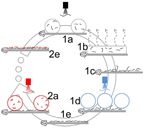| Merrill and Sun describe a new method for achieving multilayered nanolamina, called spin-spray layer-by-layer self-assembly (SSLbL), which significantly increases the efficiency of traditional LbL assembly techniques. |
Reviewed by Jeff Morse, Ph.D., National Nanomanufacturing Network
- Merrill, M.H., Sun, C.T. 2009. Fast, Simple and Efficient Assembly of Nanolayered Materials and Devices. Nanotechnology 20(7):075606. DOI: 10.1088/0957-4484/20/7/075606
Layer-by-layer (LbL) techniques are used for precise control of nanolayered composites whereby the materials and properties of each layer can be customized. LbL methods are inherently simple, typically incorporating two water-based dilute solutions each containing polymer or nanoparticle colloids with opposing charge. A substrate of specified surface charge, dipped into a solution of the opposite charge, enables the charged polymers or nanoparticles to diffuse to the surface where they attach. The deposition becomes self-limiting as the surface charge becomes overcompensated, thereby changing the surface to the opposite charge, and electrostatically repelling the charged particles in the solution. Subsequent layers are deposited by dipping the substrate into the solution containing the oppositely charged polymer or nanoparticle solution. The procedure is iterated until a multilayer, nanolaminant film is created having the desired properties of each individual layer. With this technique, customized materials compositions can be created and controlled for applications ranging from battery electrodes, fuel cell electrodes and catalyst supports to photovoltaics and a range of other custom materials. The drawbacks of this technique include slow, time-consuming process steps and low material efficiency.

The authors report significant advantages of this assembly method, including reduction of the time for coating each nanolamina pair, improvement of materials efficiency to >50%, and a tractable nanomanufacturing process that could be readily scaled to large substrates and a multitude of potential materials. The authors further report shadow masking techniques to create self-assembled patterns in the nanostructured materials, a key implication for future device or nanostructure integration at large scale.
Characterization of the multilayer nanocomposite films illustrate the relationship between surface roughness and morphology on process conditions—with the initial substrate and solution materials dictating the limits for layer thickness and surface roughness. Though the authors demonstrate the versatility of this technique to create three-dimensional nanolaminate structures, as well as high quality multilayered films, subsequent investigations are needed to clarify the range of materials that can be formed via this process approach. SSLbL, combined with tight process control, presents a simple, efficient, low-cost nanomanufacturing capability.
Image reproduced with permission from Merrill, M.H., Sun, C.T. 2009. Fast, Simple and Efficient Assembly of Nanolayered Materials and Devices. Nanotechnology 20(7):075606.
This work is licensed under a Creative Commons Attribution-NonCommercial-NoDerivs 3.0 Unported.
